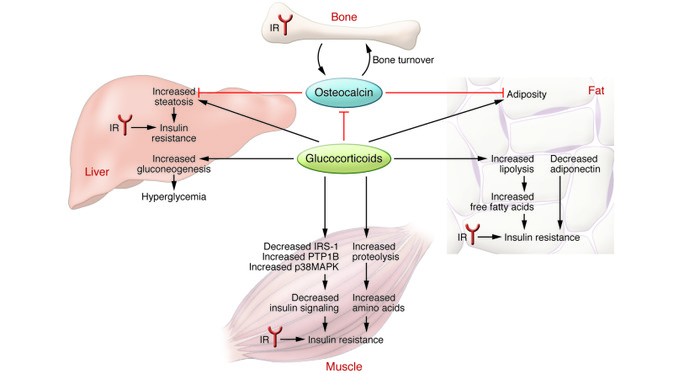Heather A. Ferris, C. Ronald Kahn
Citation Information: J Clin Invest. 2012;122(11):3854-3857. https://doi.org/10.1172/JCI66180.
Heather A. Ferris, C. Ronald Kahn
Published October 24, 2012
Citation Information: J Clin Invest. 2012;122(11):3854-3857. https://doi.org/10.1172/JCI66180.
Abstract
Glucocorticoids are a powerful tool used to treat a range of human illnesses, including autoimmune diseases and cancer, and to prevent rejection following organ transplantation. While lifesaving for many, they come with a steep price, often leading to obesity, insulin resistance, diabetes, and osteoporosis. In this issue of the JCI, Brennan-Speranza and colleagues provide evidence that the osteoblast-derived peptide osteocalcin is one of the drivers of the metabolic derangements associated with glucocorticoid therapy. This novel mechanism could open up new avenues for the treatment of these disorders.
Authors
Heather A. Ferris, C. Ronald Kahn
Figure 1
Mechanisms leading to glucocorticoid-mediated insulin resistance.
Options:
View larger image
(or click on image)
Download as PowerPoint
Glucocorticoids exert their impact on metabolism through several different tissues in the body. In the presence of glucocorticoids there is an increase in adiposity as well as an increase in lipolysis, leading to elevated free fatty acids in the circulation and an increase in insulin resistance. Muscle undergoes proteolysis, releasing amino acids that increase insulin resistance. Postreceptor insulin signaling defects such as a decrease in IRS-1 also contribute to insulin resistance. In the liver, there is increased steatosis, causing insulin resistance, which is compounded by increased gluconeogenesis and hyperglycemia. The bone is the site of osteocalcin production, driven by the IR. Osteocalcin normally participates in bone turnover as well as suppresses increases in adiposity and steatosis. These actions are inhibited by glucocorticoids.



Copyright © 2025 American Society for Clinical Investigation
ISSN: 0021-9738 (print), 1558-8238 (online)

